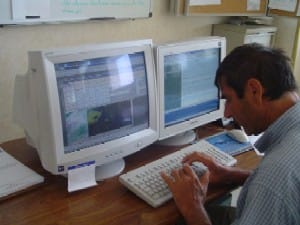Georges, Alain, Jean-Luc, and Claude the chief: four men in the wind, but also in the sun and clouds. Civil servants at MétéoFrance, they control the weather for the Alpes-Maritimes. Their stronghold is located at the Nice airport. From there, they study the sky and satellite images to make forecasts. “This is the departmental center of Météo France. Météo France is a public administrative institution with 3700 employees who have the status of civil servants. There is a center in every French department. We provide meteorological data to the airport and issue weather bulletins for the Alpes-Maritimes.” These introductions come from Claude Léglantier, departmental delegate of Météo-France, who arrived from Strasbourg a few months ago. The missions of each center are specific: to provide weather forecasts, observe the weather, and archive its measurements—that is, the climatology or, as Claude Léglantier calls it, “the memory of the weather.” 26 people (meteorologists, technicians, and climatologists) work in Nice.
The weather bulletins are updated three times a day at 7:30 am, noon, and 5 pm and are available to the “general public” by calling 32 50. The forecasts in Nice are developed from various satellite maps or forecast models sent by the Technical Center of Météo France in Toulouse. The meteorologists in Nice overlay the different maps (atmospheric pressure, air mass, etc.), analyze them, and deduce the weather for the coming hours.
The Nice center has two seasonal specialties. Because the Alpes-Maritimes are considered a high-mountain department (only about ten in France) and the five deaths this winter caused by avalanches confirm this, the meteorologists from Nice study the structure of the snow. With the voluntary assistance of high-altitude specialists, notably trackers, Météo France Nice develops avalanche risk maps. In the summer, in collaboration with the General Council of the Alpes-Maritimes, fire risk indices by geographic area are communicated to the Civil Security forces. These very useful data allow the Civil Security to optimize troop deployment.
Jean-Luc works with his head in the clouds and his eyes on computers. From the top of the old control tower, he is in charge of monitoring the readings provided by the weather stations located at the airport. The computers handle temperatures, solar radiation, wind strength, and visibility, and the individual observes the clouds, their movements, and thicknesses, the cloud cover, and visibility. Jean-Luc then informs the air traffic controllers whether the weather allows planes to land or not. The same data reaches the control tower in Nice as well as to all those who have a plane heading to Nice and to the pilots.
Other Information
Climate Change. Claude Léglantier: “There is a process of global warming with an increase in the ozone layer. Statistics show that the climate is warming but over the long term. We can have a year that is colder than another.”
Forecasts: Claude Léglantier “Currently, we can forecast up to seven days. Experimentally, we are attempting up to fifteen days, and the goal is to be able to make seasonal forecasts which will remain only trends.”
Forecast Errors: Claude Léglantier “They are rarely errors. It’s often delays. The forecasts remain good but the clouds arrive later or earlier than expected for example and without knowing too much why. We are wrong less often than those who predict stock market prices.”
Working at Météo France: Claude Léglantier “Anyone can become a meteorologist. Just put a meteorologist sign on your door! To work at Météo France, recruitment is done through a competitive exam. You can either be a technician, that is, take care of the equipment and its maintenance, for which you only need a baccalaureate, or an engineer, but you must have completed preparatory courses in science.”
Services. The weather is a service open to competition. Anything concerning the safety of people and property is free. For example, access to vigilance maps. Météo France has a pricing schedule and thus has commercial activity. The 32 50 is paid as well as the weather bulletins provided to the media or the use of climatology studies by local authorities or insurance companies for compensation after natural disasters.


